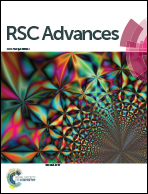Efficient and chromaticity stable green and white organic light-emitting devices with organic–inorganic hybrid materials†
Abstract
Efficient inverted bottom emissive organic light emitting diodes (IBOLEDs) with tin dioxide and/or Cd-doped SnO2 nanoparticles as an electron injection layer at the indium tin oxide cathode:electron transport layer interface have been fabricated. The SnO2 NPs promote electron injection efficiently because their conduction band (−3.6 eV) lies between the work function (Wf) of ITO (4.8 eV) and the LUMO of the electron-transporting molecule (−3.32 eV), leading to enhanced efficiency at low voltage. The 2.0% SnO2 NPs (25 nm) with Ir(ddsi)2(acac) emissive material (SnO2 NPs/ITO) have an enhanced current efficiency (ηc, cd A−1) of 52.3/24.3, power efficiency (ηp, lm W−1) of 10.9/3.4, external quantum efficiency (ηex, %) of 16.4/7.5 and luminance (L, cd m−2) of 28 182/1982. A device with a 2.0% Cd-doped SnO2 layer shows higher ηc (60.6 cd A−1), ηp (15.4 lm W−1), ηex (18.3%) and L (26 858 cd m−2) than SnO2 devices or control devices. White light emission was harvested from a mixture of Cd–SnO2 NPs and homoleptic blue phosphor Ir(tsi)3; the combination of blue emission (λEL = 428 nm) from Ir(tsi)3 and defect emission from Cd–SnO2 NPs (λEL = 568 nm) gives an intense white light with CIE of (0.31, 0.30) and CCT of 6961 K. The white light emission [CIE of (0.34, 0.35) and CCT of 5188 K] from colloid hybrid electrolyte BMIMBF4–SnO2 is also discussed.



 Please wait while we load your content...
Please wait while we load your content...